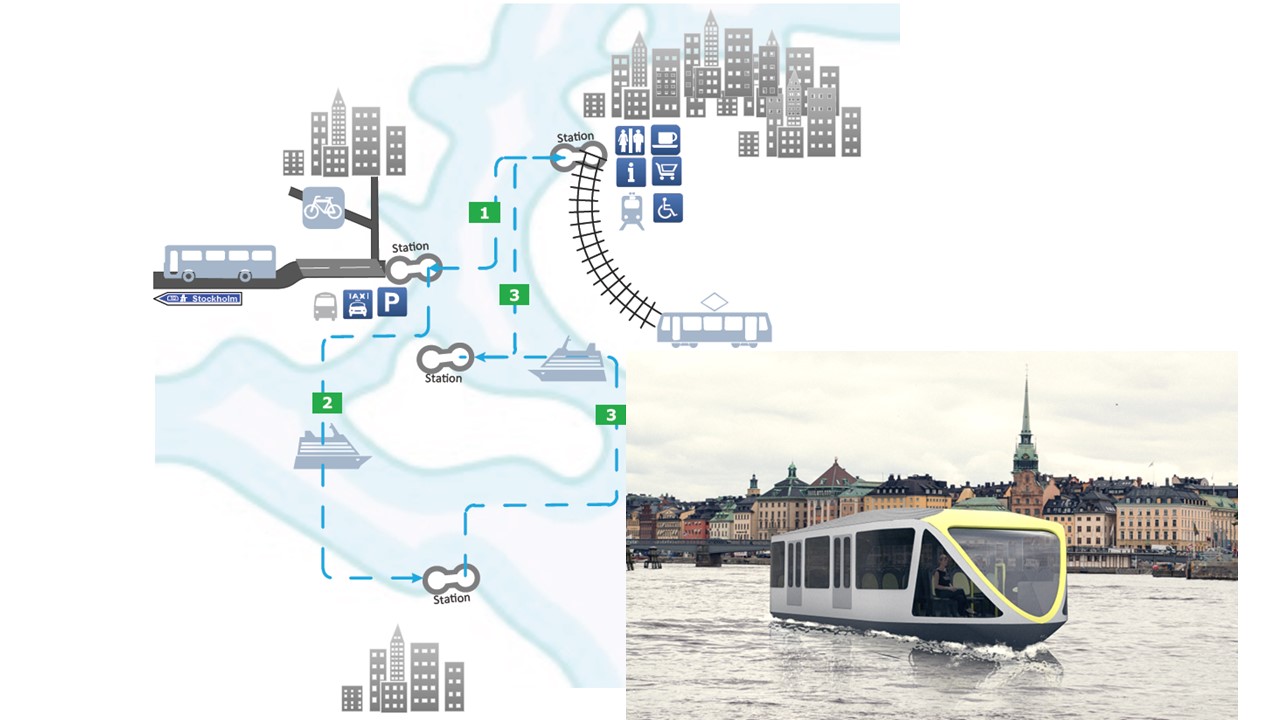- WATERBORNE URBAN MOBILITY

På svenska längre ner!
The project aims at illustrating modern waterborne commuter vessels, their design and how those year-around units are incorporated in tools for strategic public transport planning. The results contribute to developing the design of standardized smaller and lighter ferries and improving planning tools to assess effects on the transport system from the waterborne mode and its technology development. Main questions are:
- Which ship-type, shape and size is the most beneficial for public transport, considering functionality, manufacturing, operation, maintenance and recycling?
- Which materials and material concepts are best suited to meet this?
- How to assess and compare different multimodal public transport solutions?
The project has three branches:
- Modular ship design
- Lightweight hull design for Nordic conditions
- Simulation-based strategic planning tool for multi-modal (rail-road-sea) public transport systems
The two first result from pre-studies by KTH Centre for naval Architecture and the Stockholm County Council (SLL) in 2016-17. The third is a further development of the Swedish Transport Administration’s MATSim Stockholm model to incorporating the waterborne mode and its terminal solutions and new vessel concepts together with the land borne public transport system and road traffic. The project is presently supported by Swedish Transport Administration, Stockholm County Council and the Swedish maritime competence centre Lighthouse and developing in cooperation with the Swedish National Road and Transport Research Institute VTI and the Hamburg-Harburg University of Technology TUHH.
Results; references to reports and papers at the end of the page!
Projektet ska visa hur moderna pendelbåtar kan utformas, konstrueras och hur den vattenburna året-runt trafiken kan föras in i den strategiska planeringen av kollektivtrafik. Resultaten ska bidra till utveckling av mindre och lättare tonnage samt av planerings-underlag för att bättre kunna bedöma effekterna av vattenburen kollektivtrafik och av teknikutveckling inför kravställning till upphandling av pendelbåtstonnage. Huvudfrågorna för projektet är:
- Vilken fartygstyp, form och storlek är mest lämpad i kollektivtrafiksystemet med hänsyn till funktionen, tillverkningen, driften, underhållet och återvinningen?
- Vilka material och materialkoncept svarar bäst mot detta?
- Hur bedömer man effektsambanden (t.ex. trängsel, framkomlighet, restid dörr-till-dörr, energieffektivitet, buller, utsläpp, underhålls- och driftskostnader, etc.) mellan olika alternativa kollektivtrafiklösningar i ett multimodalt system (räls-sjö-väg)?
Projektet är uppdelat i tre grenar:
- Modulär fartygsdesign
- Lättviktskrov för nordiska förhållanden
- Simuleringsbaserat planeringsverktyg för multimodala (spår-väg-sjö) kollektivtrafiksystem
De två första är formulerade efter förstudien Hållbart pendel- och skärgårdtonnage som KTH Marina system genomförde i samarbete med Stockholms Läns Landsting, SLL. Den tredje är en vidareutveckling av Trafikverkets modell MATSim Stockholm så att vattenvägen, brygg- och terminallösningar och det nya tonnaget inkorporeras i ett verktyg tillsammans med övrig kollektivtrafik och övrig vägtrafik. Projektet finansieras idag av Trafikverket, Stockholms Läns Landsting och det maritima kompetenscentret Lighthouse och utvecklas i samarbete med Statens väg- och transportforskningsinstitut VTI Hamburg-Harburg tekniska universitet TUHH.
Results/resultat:
- Cheemakurty H., Tanko M. and Garme K. (2017). Urban waterborne public transport systems: An overview of existing operations in world cities, Report TRITA-AVE 2107:92, Royal Institute of Technology, Stockholm Sweden.
- Tanko M., Burke M., Cheemakurthy H. (2018). Water transit and ferry-oriented development in Sweden: Comparison with system trends in Australia, Transportation Research Record, https://doi.org/10.1177/0361198118782275, 2018.
- Cheemakurthy H., Zhang M., Ehlers S., von Bock und Polach F., Garme K. & Burman M. (2018). Statistical Estimation of Uncertainties associated with Ship Operations in fresh water ice, accepted for publication in the proc. of int. conf. ISOPE, Sapporo Japan June 2018.
- Tanko M., Cheemarkurthy H., Hall Kihl S. & Garme K. (2019). Water transit passenger perceptions and planning factors: A Swedish perspective, Travel Behaviour and Society vol. 16 pp. 23–30, 2019.
- Flötteröd G. (2020). Waterborne Urban Mobility, VTI PM D.nr.: 2018/0356-7.1, vti.se/publikationer.
- Cheemakurthy H. (2020). Efficient commuter craft for urban waterborne public transportation, Licentiate Thesis, KTH TRITA-SCI-FOU 2020:50.
-
Cheemakurthy H. & Garme K., A modularly tailored commuter ferry platform, International Shipbuilding Progress, vol. 69, s. 1-35, 2022.
-
Cheemakurthy H. & Garme K., Fuzzy AHP-Based Design Performance Index for Evaluation of Ferries, Sustainability, vol. 14, no. 6, s. 3680-3680, 2022.
-
Cheemakurthy H., Barsoum Z., Burman M. & Garme K., Lightweight Structural Concepts in Bearing Quasi-Static Ice Hull Interaction Loads, Journal of Marine Science and Engineering, vol. 10, no. 3, s. 416-416, 2022.
-
Cheemakurthy H., Barsoum Z., Burman M. & Garme K., Comparison of Lightweight Structures in Bearing Impact Loads during Ice–Hull Interaction, Journal of Marine Science and Engineering, vol. 10, no. 6, 2022.
-
Cheemakurthy H., Framework for holistic design of ferries focusing on lightweight ice going hulls, PhD thesis, TRITA-SCI-FOU ; 2022:45